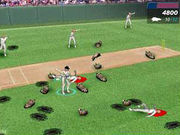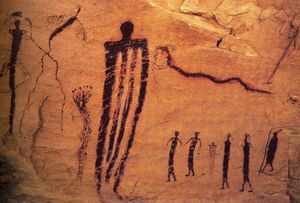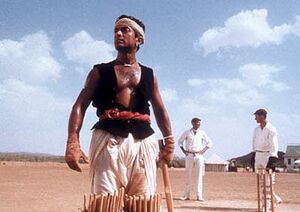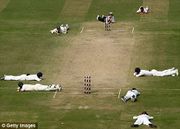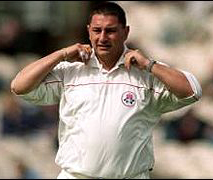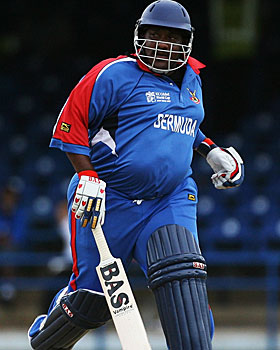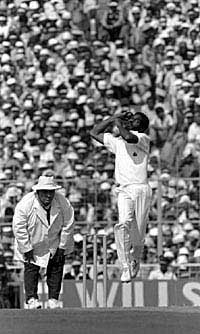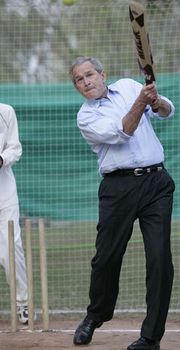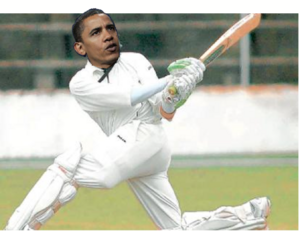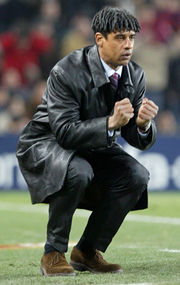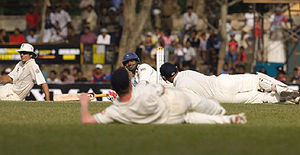Cricket
This article may be Overly British |
“It’s like baseball, right?”
– every American, ever on cricket
Cricket is played all over the world by eccentric idiotic police constables and others who would like to emulate them. It is also played in Australia and Yorkshire, and unlike rounders, it is not the same as baseball.
It is an apparently pointless sport with rules which few people really understand, involving 11 men standing around in a field who occasionally run around, but on the whole stand completely motionless hoping something might happen. Cricket is universally considered one of the most boring and tedious of sports, but continues to be popular the world over with the boring and tedious.
Origins
People have always been hitting balls with sticks, and archaeologists agree that certain quirks unique to cricket indicate that the sport was played in ancient or even pre-historic times.
- The side-on stance of batsmen suggests that cricket pre-dates the evolutionary processes that caused the eyes to move from the sides of the head to the front of the face.
- The straight-arm action of (most) bowlers suggests that cricket may date to a time before the development of the elbow joint in modern apes.
- There is no archaeological evidence for any other sport involving the consumption of meals during matchplay (with the obvious exception of indoor sports such as darts and poker). This practice may have arisen from ritualistic cannibalism where the proto-human batsman was killed and eaten after being given "out" by the umpire.
Cricket is not rounders.
The game in its current format cricket was first mentioned in literature in a now-lost book of St. Paul (First Letter to the Third Umpire) which questioned a decision made in a game between the Corinthians and the Ephesians.
A passage from the book is often quoted by lovers of the game when asked what it means to be a cricketer:
A cricketer is patient, a cricketer is kind. He does not envy, he does not boast, he is not proud. He does not dishonour others, he is not self-seeking, he is not easily angered, he keeps no record of wrongs. He does not delight in evil but rejoices with the truth. He always protects, always trusts, always hopes, always perseveres.
Unfortunately, it appears that St. Paul did not practise what he preached. Contemporary services suggest he threw his bat at an opposing player and was sent to the pavilion, located in Rome, to answer for his unsporting behaviour.
The Romans viewed cricket as a Jewish game and eventually banned it in favour of more gladiatorial contests.
The Dutch
The game of cricket was then lost until the 17th century when the Dutch found an old set of rules hidden in a book in Amsterdam. The Dutch, known for tolerating a lot of things that earned you either a hanging or burning in the rest of Europe, called the game Krookeet and liked its slow, thoughtful pace, as it provided plenty of opportunities for a gin break or a long smoke on a clay pipe.
It is possible that Krookeet would have stayed a Dutch peculiarity but for what are called the Anglo-Dutch Tulip Wars, in which England and the United Provinces (which was what the Dutch called their country then) took each other on in a series of wars at sea.
In 1667, the Dutch fleet forced their way up towards the English port of Chatham in Kent where they captured and burnt the English fleet as it was at anchor. The Dutch had discovered the English sailors were on shore playing a rough game of 3,000-a-side football and had neglected to keep anyone sober on watch.
To add to the British humiliation, the Dutch bombarded Chatham with Krookeet balls containing instructions for "a game which is too civilised for you lot".
In the generations that followed, however, the Dutch slowly lost interest in Krookeet in favour of developing their trade in exotic substances and making advances with various forms of exotic and more interesting sex. This left the field clear for the English to pretend they invented cricket and everyone believed them because they had far more convincing beards.
The English
The Englishmen gradually evolved the sport into a form known as Test Match Cricket. This required five days of good weather of hitting and throwing a ball to win. At this point the game became unplayable in England, and so countries with better weather were sought in which to play the game, via the painless medium of colonialism.
The process began by accident. British Officers stationed abroad played the game out of boredom, but they noticed that it had a mesmerising, narcotising effects on locals, who often fell asleep during the first innings.
This allowed the British to ease the spears out of their hands, turn the fire down on the cannibalistic cooking pots, and begin the complicated process of renaming all the villages after English things, and spreading the word of Protestantism. Harare! Hurrah!
As Indian historian Sunil Gaviscon recounts, "The last thing I remember, it was 218–2 ... by the time I woke up, there was a Union Jack on my flag."
A secondary factor in cricket's spread was that it was touted as a gentleman's game, and if any colonial subject wanted to earn the respect of the British, he had to play cricket, and do so in the correct way. Many natives fell for this, believing that if they actually beat the British at their own game, it would change their overlords' supercilious view of them. This has not yet come to pass.
In the 20th century, the Australians developed "One Day Cricket" because many of their best players could only obtain day-release from prison, and this was sold back to the English, who retaliated with the even shorter "Twenty20 Cricket". The game was now reduced to a blink-and-you'll-miss-it three hours.
Thus the sport is gradually moving towards a quicker format, and it is predicted that by the year 2020 a typical match of International Test "Quick Cricket" or "Tip and Run" will take about five minutes, leaving more time for drinking in the bar.
Rules
Cricket is simple, as summarised by the International Crocheting Club (ICC).
- Each game requires two teams, who get to hit their balls (when they are called the batsmen and not batters as in Baseball, or batty as in Northern Englishmen) or to bowl (not pitch or throw or chuck) their balls then chase after them (fielding).
- The Toss Before the game commences, the umpire watches both captains toss, and one is allowed to elect whether to bat, field, or go to the pub.
- One round of hitting the balls is called an innings, always with an s, even in the singular, to confuse Americans.
- Some games last five days, some take two innings or less, e.g. rain or the spectators go home.
- Each team has 12 players each although only 11 play and the 12th man is called the "12th man" who gets the drinks. One team fields and bowls, and the other bats. Batting is the only remotely interesting part of the game to watch, but bowling is also popular as a participatory sport, as you are allowed to try and hurt the batsman.
- When the batsman who's in is out, then he goes off and the next man comes on until he's out. The object of the game for the batsman therefore is to make sure he doesn't get out. The end of an innings is declared when 10 batsmen are out, even though there are 11 playing not counting the 12th man. So there is a batsman still in although his team is out, but he has to go off. When the batsmen are all out, the side that's out comes in and the side that's been in goes out and tries to get those coming in out.
- There are two additional fat men called umpires who stay all out all day and give the batsmen who are in out. So long as they are out. But a batsman is not out unless the fielders appeal first to the umpires by giving them various gifts, glances or sly winks and nudges. If the umpires don't like something, such as player interfering with another player behind the sight screen, then the umpires can declare that it's simply not cricket which means it's cricket but shouldn't be.
- An over is over when the bowler has six or sometimes eight balls, depending on how over the line he was or how far over the limit the umpire is. Many umpires count their balls in their pocket until it's over to make sure. An innings may be over after 55 overs, or 40, or 20, or sometimes a lot less if there has been a "follow-on", if you follow, or declare for that matter.
- Follow-on Basically, if one team's batsmen are all out so the innings is ended but they haven't scored enough maidens to avoid being "Toffed", then a Follow-on is declared. The batting team then forfeits their tea and is forced to bat again without being allowed to adjust their sticky wicket. Not to be confused with a follow-through.
- When both sides have all been in and all the men have been out, including those who are not out (if they declared), and both sides have been out twice or maybe once or less if someone declared or it rained, then that is the end of the game.
- If the bowler hits an off-stump leg-bye then a sticky wicket is called and the game breaks for tea; however, should a "tickle down the leg side" be called, unless it's caused by a spin-twist shot or a slippy duck, then the innings may be declared over or the over under the innings. In the case of the deep-wide short-fine leg being run out by the slip's backward point boundary man, the batting team are forced to substitute their 12th man for a golden duck and a cup of Dilmah Tea.
Despite the apparent simplicity of these rules, there remain a number of uncivilised nations in Northern Europe and North America and North Africa who are yet to embrace the gentrifying effects of the game of cricket.
Fitness and fashion
Cricket is a deceptively demanding sport; players spend a long day on their feet at the bar, waiting to be served or to bat. However cricketers must be relatively "fit" as they may need to perform periodic fast sprints to the toilet, rubbing of balls, various dynamic movements such as dodging policemen, as well as leaping in the air from a prone position and sprinting to avoid husbands. Dodging cans of beer while fielding near the crowd also maintains awareness and selects for a thick skull. Being overweight can be advantageous when receiving a fast ball in the stomach (Gut Before Wicket) although finding and disgorging the ball from the layers of flab can be difficult for ground staff.
Modes of dismissal
There are many ways to get out in the game of cricket.
Run out A batsman may be in for such an abominably tedious length of time that he runs out of enthusiasm for playing any further and leaves the field in order to find the nearest drinking establishment.
Bowled This occurs when a sadistic delivery from an ultra-fast bowler takes the hair off the batsman. The batsman needs to duck in this situation to avoid being out, so that he becomes out anyway.
LBW Although no cricket analyst has ever worked out what this stands for, the most frequent guess was that it "sounds like a band of some sort." Consequently LBW is the official term given for dismissing a batsmen who uses one of his three legs (two long and one short leg): the left, the right or the middle or all three of them as one to stop the ball instead of using his bat.
Stumped The batsman can be stumped when asked a extremely difficult question, but also can happen to older umpires who are unable to remember the score.
Caught The batsman is caught performing some socially unacceptable act, which is declared "not cricket". He must then leave the field in embarrassment. The rules in cricket are so fickle in places that Ian Botham, legendary all-rounder, was caught on camera picking a bogey and swallowing it whole, and had to walk, but Phil Tufnell regularly got away with skinning up and smoking spliffs while fielding in the slips.
Handled the ball Due to the very itchy nature of the fabric used in cricket underpants cricketers constantly need to rub their trousers in an attempt to relieve themselves. A player may attempt strategic rubbing of the surface of one side of the ball against their genitals through their trousers, but will be given out if they directly handle their penis.
Obstruction This occurs when a batsman attempts to interfere with a fielder. This usually involves placing an object such as a tank-trap, barbed-wire fence, brick wall or other obstruction in the way of the fielder.
Hit wicket When a batsman is unceremoniously hit in his middle stump while trying to play a stroke causing him to fall to the ground in extreme pain, he is thus forced to walk, but more usually waddle or crawl while carefully nursing his third man.
Retired out Sometimes during extremely long matches batsmen may pass the mandatory retirement age (65 in many countries) and be forced to leave the field to play bingo.
Not cricket This is the most perplexing form of dismissal for "foreigners" (non-cricketing nations) to understand. If something "isn't cricket", then it is "just not on, old boy", in which case you are dismissed "and it serves you bloody-well right." A Not cricket decision is signalled by sounds of "Tut-tut" and "Harrumph" from the Members' Stand. This therefore is related to but varies from Toffing (see below). The umpire will then dismiss the player by waving his handkerchief in the direction of the player and blowing his nose loudly in it.
Six and Out This happens when the ball is hit over the fence and into the back garden of the neighbour, who then refuses to give the ball back. The batsman is given six and out, and his parents are obliged to pay for a replacement ball.
Toffed A batsman of a lower class may be given out toffed if there is sufficient condescending frostiness from the more wealthy spectators. This frostiness may be expressed through symbolic gestures, such as sleeping, reaching one's 80th birthday, or gazing indifferently into the rim of a straw trilby. This traditional but controversial rule has only been exercised once, in a match between Eton Old Boys' XI and Slough Urchins XI at The Oval in 1922, when the entire Slough team was given out toffed, basically forfeiting their entire innings. Eton went on to win by 4 runs.
Sledging This method of dismissing the batsman was first perfected by the Australian Test XI in 1952. "Sledging" a batsman involves calling nasty names or saying horrible (and untrue!) things about his mother. The batsman is judged to be sledged when he breaks down in tears and is unable to carry on, at which stage the square leg umpire will bring on the symbolic handkerchief for him to blow his nose, after which he will go back to the pavilion where he is allowed to telephone his parents.
Positions
While playing cricket, 97% of the time is spent not actually playing cricket. Even if you are on the field, which you are probably not, but even if you are, you are almost certainly not spending all of your time actually playing cricket. Thus, in an attempt motivate people who are not batting or bowling to go onto the pitch a series of "fielding positions" have been created to give the illusion that fielding is something mystical, and not just players waiting around for their turn. A realisation of this has driven many fielders insane as they wander forward several feet every time the ball is bowled, and clapping their hands at the sky.
Batsman Cricket is not a sexist sport, and so even women who bat are called batsmen rather than batswomen. Batting is the only relatively interesting part of the game which explains the annoyance seen in batsman when their turn is over and they are forced to go back to either standing or sitting in the stand.
The Runner The batsman to whom the bowler doesn't bowl. He is used when the batsman is too overweight, or rich to run between the wickets himself.
Wicket Keeper This is a very important position, especially during Test Matches which may last five days, occasionally with a result. At the end of each day, "Stumps" is declared by the umpires, and the wicket is given to the wicket keeper to guard overnight.
Umpire There are numerous umpires. The two on-field umpires are un-officially hired fat old men, one of whom stands behind the bowler's wicket (the wicked umpire) and one who hides in the field. A new "third umpire" or "television camera" has recently been introduced to the game.
Slips The extremely lazy prefer to field in the slips, just behind and to the side of the batsman, as it requires no physical movement whatsoever, and is also popular with those wishing to smoke whilst on the field. The position is named after the aforementioned Ian Botham, who, when being accused of lying around doing nothing, claimed he had "just slipped over."
Gully Usually where the most difficult catches and therefore most gullible player is usually found.
Fine leg Any fielding position where the fielder insists on wearing shorts rather than pyjamas in order to show off his freshly-waxed legs.
Long Leg A fielding position reserved for the oldest player in the team. They are allowed to drink refreshments and eat sweets provided by the crowd.
Short leg This is not the disadvantage one would think. David Boon from Tasmania and Sachin Tendulkar from India had short legs on both sides and still performed remarkably well.
Silly point A fielder at silly point is generally no more than 3 yards from the batsman and will attempt to get the batsman in fits of laughter using a series of jokes and entertaining costumes until he is unable to play.
Stupid point A fielder at stupid point is generally no more than 1 foot from the batsman and will attempt to block the ball using his face. The position also offers an excellent opportunity for those fielders who smoke to try to disrupt the batsman with passive smoke inhalation.
Cover A Cover position is responsible for covering the pitch when it starts raining.
Point The Point's job is to stand and point at the ball so that other players and cameramen know where to look. During the drinks breaks it is also his responsibility to point out the slappers in the crowd.
Third man Usually a large, dim-witted player who isn't good enough to field with rest of the team, and whose main responsibility is to shift his bulk left and right in an attempt to not excessively embarrass the rest of his team mates. May also play the zither and lurk in the background where the screens are kept.
Twelfth Man The person who brings out the drinks.
Doggie Nothing to do with cricket, but a fine position nonetheless.
Batting shots
Forward Defensive An ironically named shot, as it implies that the team's position moves forward. In fact, the batsman moves forward to block the ball into the ground, but often hits the ball straight to Silly Point. Cricket pundits Boycott and Lawry were able to bat for several months without getting out (and sometimes scoring 30) using this technique.
Backward Defensive ˙ʇǝʞɔıɹɔ ɥsıןƃuǝ oʇ uoıʇnqıɹʇuoɔ sıɥ ɹoɟ sqnןɔ ɹǝɥʇo ɯoɹɟ ʎǝuoɯ ɟo ʇunoɯɐ ǝƃɹɐן pıɐd uǝʇɟo sɐʍ ǝɥ ˙sunɹ ǝɹoɔs oʇ uɹoqqnʇs ooʇ ƃuıǝq puɐ ʇoɥs sıɥʇ ɟo ǝsn sıɥ ɥʇoq ɹoɟ snoɯɐɟuı sı ʇʇoɔʎoq ʇıpund ʇǝʞɔıɹɔ ˙ʇuıod ʎןןıs oʇ ʇɥƃıɐɹʇs ןןɐq ǝɥʇ sʇıɥ uǝʇɟo ʇnq 'punoɹƃ ǝɥʇ oʇuı ןןɐq ǝɥʇ ʞɔoןq oʇ pɹɐʍɹoɟ sǝʌoɯ uɐɯsʇɐq ǝɥʇ ˙pɹɐʍɹoɟ sǝʌoɯ uoıʇısod sɯɐǝʇ ǝɥʇ ʇɐɥʇ sǝıןdɯı ʇı sɐ 'ʇoɥs pǝɯɐu ןןʎɐɔıuoɹı uɐ
Hook Drive. The batsman dresses up like Peter Pan's enemy and tries to hit the ball with his steel claw. Risky shot but fans go crazy for it.
Pull Usually fruitless attempt by the batsman to get on the front foot and convince a lady to go home with him that night.
Square Drive An attempt by some of the members to encourage others to dress in particularly traditional attire by virtue of playing cards together.
Straight Drive The most heterosexual of cricket shots. This involves the batsman driving his Mercedes directly down the wicket in an attempt to kill to the match umpire.
Sweep The batsman goes down on one knee to look into a mini-fridge. He then sweeps the contents of the fridge into his box where he mixes a cocktail. The fielding side is then forced to take a sip the contents of the cocktail, tip the waiter, and are usually thrown out by a bouncer for a full toss.

Reverse Sweep As above, but with lager.
Terminology
Bodyline Trying to decapitate an opponent's body by staying just in-line with the rules.
Bouncer A fat, tattooed, muscular gentleman running down the pitch who attempts to prevent the batsman from playing by claiming that his name is not on the list, and as such he is not coming in.
Chinaman Trying to bowl backwards while eating noodles.
Googley An early version of Google, invented by Tim Berners-Lee. No advertising links.
Off Break A ball that goes so wide it ends up in the Square Leg Umpire's hat.
Maiden If a batsman was unable to score off three maidens in a row, the bowler was rewarded with all the other the available maidens in a given town. Discontinued due to changing social conditions in England. Many early games of cricket were played in Maidenhead, Berkshire but that may be a coincidence.
Yorker Pitching a ball at a batsman in such a way that it breaks out into the local accent of Yorkshire. Call that a delivery? Are you from London yer soft pansy Southerner?
Slower Ball This ball is mentally retarded and has trouble focusing on the task of getting the batsman out.
Carrom ball occurs when the bowler bowls the carrom table instead of the ball. But yet this delivery might severely injure the batsman or wicket-keeper (if batsman makes a leave) thus it's considered illegal outside the India - the home of carrom and interestingly in Zimbabwe where they do not know what carrom actually is so they couldn't ban it.
Leg cutter This delivery is bowled using sharpened ball or more preferably shuriken in an attempt to cut off the batsman's leg who can protect his leg using titanium pads. If his leg is cut off then leg bye rule is applied.
See also
- Michael Holding
- Cricket terminology
- Cricket commentary
- Wisden Cricketers' Almanac
- TMS
- Ashes
- Border Gavaskar Trophy
- Allahakbarries
- Mark Robinson
- Australian cricket team
- Age of Umpires
